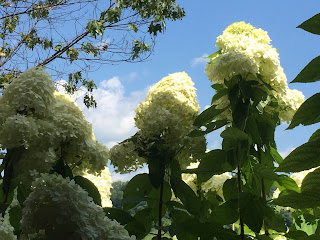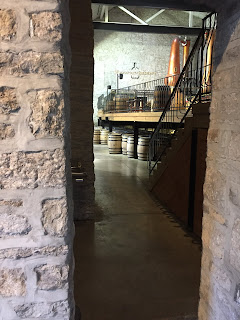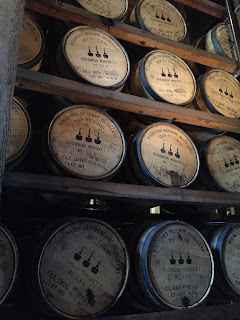To live at Merry Mount requires a decent amount of daily work, but Rett and I find that the rewards far outweigh the distresses. Vacations for us are few and far between, for we rarely want to vacate. Occasionally, however, we take a few days away. Last weekend we joined our dear friends, Mark and Laurie, on a short trip to Louisville, KY.
Now most of you are aware that Rett and I
occasionally sip on a fine bourbon or scotch whiskey. So “it was fittin’” that we made four stops
along the “Bourbon Trail”. We visited Angel’s Envy, Jim Beam, Maker’s Mark, and
Woodford Reserve. Unfortunately, we can not send a taste of
each bourbon out to you, but we can offer a few snapshots of our experience.
Before we begin, allow me to share a bit of what
we learned. I refer you to a 3/22/2012
article by David K. Israel that answers the question, “What makes a whiskey bourbon?”
The law. While knocking back a
dram of bourbon is a decidedly carefree exercise, making it is exceedingly
technical and requires that the whiskey meet a rigid set of criteria. The
Federal Standards of Identity for Bourbon stipulate what is and what isn’t
bourbon. For a whiskey to call itself bourbon, its mash, the mixture of grains from
which the product is distilled, must contain at least 51% corn. (The rest of
the mash is usually filled out with malted barley and either rye or wheat.)
The
mash must be distilled at 160 proof or less, put into the barrel at 125 proof
or less, and it must not contain any additives. The distillate must be aged in
a new charred oak barrel. (Most often these barrels are white oak, but they can
be any variety of oak.)
If you distill a whiskey in your kitchen that meets all
of these standards, congrats, you’ve made bourbon. Also, you’ve broken the law;
the ATF is probably outside your house right now.
The main difference between
scotch and whisky is geographic, but also ingredients and spellings. Scotch is
whisky made in Scotland, while bourbon is whiskey made in the U.S.A, generally
Kentucky. Scotch is made mostly from malted barley, while bourbon is distilled
from corn. If you’re in England and ask for a whisky, you’ll get Scotch. But in
Ireland, you’ll get Irish whiskey (yep, they spell it differently for a little
colour).
On this
side of the pond, we have our own local color, too. The difference between
Tennessee Whiskey, like Jack Daniel’s, for example, and Bourbon is that after
the spirit is distilled, Tennessee Whiskey is filtered through sugar-maple charcoal.
This filtering, known as the Lincoln County Process, is what distinguishes
Tennessee Whiskey from your average Bourbon, like Jim Beam. The name, Bourbon,
comes from an area known as Old Bourbon, around what is now Bourbon County,
Kentucky.
 |
| Bustling downtown Louisville. According to David Junk, this Gibson guitar is a replica of an ES 335, B.B. King's "Lucille". |
Let's begin our photo tour.
First stop, Angel's Envy:
First stop, Angel's Envy:
 |
| L to R: Thomas Krcmaric, Pat, Rett, Laurie, and Mark |
 |
| A dram of Angel's Envy and an "Old Goat" at the end of the tasting table |
 |
| A plaque that hangs inside Angel's Envy |
 |
| Our Wilmer ready to race |
 |
| Pat pointing to his Angel (Rett) |
Second stop, Jim
Beam:
 |
| A dram straight from the barrel |
 |
| Rett offering up a dram |
 |
| Rett adding thumbprint to the wax seal of her bottle of Knob Creek |
Third stop, Maker’s
Mark
 |
| View of hydrangeas against a blue sky while taking a respite on the porch |
 |
| Mark after dipping his bottle in the famous Maker's Mark red seal |
In conclusion, I would be remiss if I did not
suggest to you a book by Ohio writer, Gene Logsdon: Good Spirits, ISBN I-890132-66-7.
We, obviously, had a wonderful time on our
vacation, but upon our return to Merry Mount, we cheerfully exclaimed, “There’s
no place like home!”
 |
CPW
P.S.
There once was a man from Kentucky
Who considered himself mighty lucky.
He’d pour her a dram,
Nod, “of course, yes Mam”
Then off they would go feelin’ fucky.












This should be required reading for beverage students....and all lovers of bourbon!!
ReplyDelete